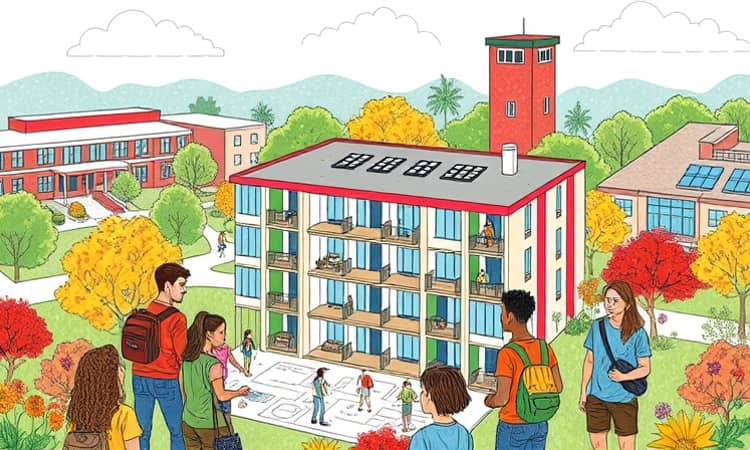In 2025, the student housing landscape stands at a crucial crossroads. Rising costs, regional disparities, and housing insecurity threaten educational success and student well-being. Yet, across the nation, innovative strategies, policy reforms, and community-driven initiatives are emerging to ensure that every student can access secure shelter during their studies.
This article explores the root of the affordability crisis, examines current market trends, and highlights practical solutions—ranging from financial mechanisms and policy interventions to community-based models—designed to lift the burden of excessive housing costs off college students’ shoulders.
Understanding the Affordability Crisis
The U.S. Government defines affordable housing as housing that consumes 30% or less of a household’s income. Unfortunately, student housing often exceeds this threshold, forcing many learners into tough compromises. According to the Hope Center at Temple University, in 2024, 15% of community college students experienced homelessness and 51% faced housing insecurity.
Between 2012–13 and 2022–23, dorm prices at four-year institutions soared by 37%. Meanwhile, extremely low-income renters—11% of whom are students—struggle to find stable living arrangements. This crisis not only impacts physical well-being but also correlates with lower retention rates, academic performance declines, and heightened stress levels.
Current Market Trends and Challenges
The 2025 student housing market reveals mixed trends. Preleasing for the 2025–26 school year hit 73.2% in April, up from 71.8% in the previous year. These figures mask significant regional variation:
- Top preleasing performers include: Alabama (95.1%), Missouri (94.7%), Virginia Tech (94.0%)
- Struggling markets include: Houston (39.2%), UT-Arlington (39.4%), Temple University (51.3%)
Average advertised rent per bed at Yardi 200 properties reached $917 in April 2025, reflecting modest growth of 2% year-over-year. By contrast, strong markets like New York exceed $2,000 monthly for a single bed, and California averages often top $1,500. Students living within half a mile of campus pay 15–20% more than those farther away.
These numbers underscore how proximity, local policy, and market dynamics converge to shape housing burdens.
Innovative Financial and Policy Solutions
Addressing the affordability crisis requires a multi-pronged approach that blends public funding, policy reforms, and private partnerships. Key strategies include:
- Government grants and subsidies: Federal, state, or local funding can lower development costs and reduce student rent.
- Quasi-public housing corporations: Partnerships between governments and developers to build mixed-income student housing.
- Vouchers and rent assistance: Means-tested support programs that cap rent at 30% of student income.
- Labor-for-rent programs: Students contribute on-campus or community service in exchange for lower housing costs.
Legislative action is also vital. Some states have enacted zoning reforms to allow accessory dwelling units (ADUs) near campuses, unlocking a new supply of affordable units. Others incentivize campus-adjacent developments through tax credits and density bonuses.
Community-Driven and Campus-Based Approaches
Beyond financial tools, community and campus stakeholders play a pivotal role. Collaboration between colleges, nonprofits, and local governments can yield tailored solutions.
- Wraparound services: Integrated support that connects students to food pantries, counseling, and emergency funds alongside housing.
- Community land trusts: Nonprofit ownership of land reserves housing developments to stabilize long-term rents.
- Campus-operated residences: Colleges develop on-campus apartments specially priced for low-income or part-time students.
- Neighborhood cooperatives: Student-led housing co-ops where residents share responsibilities and decision-making.
Successful examples abound. A Texas community college transformed an unused gym into modular dorms with on-site childcare. In Washington State, a partnership between a public university and a housing nonprofit produced 500 affordable beds capped at 25% of tuition revenue.
Practical Steps for Students
While systemic change takes time, students can adopt strategies today to reduce housing costs and mitigate risks.
- Expand your search radius: Explore neighborhoods one to two miles from campus where rents drop 10–20%.
- Form roommate alliances: Sharing multi-bedroom units can slash per-student rent by up to 50%.
- Negotiate with landlords: Offer to sign longer leases or pay upfront for a discount.
- Leverage campus resources: Seek emergency housing grants, legal clinics, or roommate-matching services.
Budgeting tools and housing workshops are often available through student affairs offices. Proactive planning—especially before peak preleasing seasons—can secure better deals.
Conclusion: Building a Collective Future
The housing affordability crisis for college students is not inevitable. By combining targeted policy reform with community innovation and student agency, we can forge pathways to stability and success.
Universities, local governments, developers, and students themselves must collaborate with urgency and creativity. When housing costs cease to overshadow academic potential, every student gains the freedom to focus on learning and personal growth.
Now is the moment to invest in student housing as a cornerstone of educational equity. Together, we can ensure that affordable roofs shelter the dreams and aspirations of the next generation of leaders.
References
- https://www.multihousingnews.com/national-student-housing-report-may-2025/
- https://www.walkerdunlop.com/news/student-housing-report
- https://collegehouse.com/news-and-insights/student-housing-in-2025/
- https://www.multihousingnews.com/national-student-housing-report-february-2025/
- https://magicdoor.com/blog/student-housing-statistics/
- https://ctb.ku.edu/en/table-of-contents/implement/physical-social-environment/affordable-housing/main
- https://www.richmondfed.org/region_communities/regional_data_analysis/surveys/community_college/community_college_insights/2025/housing_solutions_community_college_students














